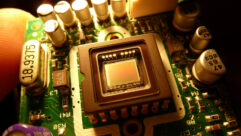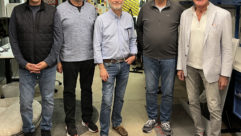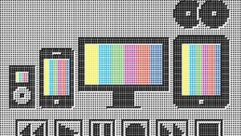DTV: It Really Works!
Believe it or not, we’re almost a decade along with the transition to digital terrestrial television
THE FIRST DTV (ATSC) stations came on the air in 1997, and the original cut-off date for analog (NTSC) was supposed to be Jan. 1, 2007. (It’s since been moved to Feb. 17, 2009.) As the DTV ball began rolling in 1998 and 1999, the first set-top receivers came to market from Zenith, RCA, and Panasonic. These products all used first-generation demodulators and equalizers based on the Vestigial Sideband (VSB) system, first developed and patented by Zenith, and later acquired by LG Electronics.
Early on, reception results were spotty. Urban areas with heavy signal multipath and multiple echoes were a disaster, while fringe areas with weak signals suffered from lots of dropout. Numerous interest groups and broadcasters suggested that the VSB standard wouldn’t cut it, and the United States would be better served by adopting the European DVB standard, which employed Coded Orthogonal Frequency Division Multiplexing (COFDM).
It may have been a tempest in a teapot back then. There were few DTV broadcasters on the air, and very little programming was carried in HDTV formats. Many DTV stations had abbreviated operating hours, and quite a few were running a fraction of their authorized transmitting power. DTV set-top boxes were expensive and few people were willing to make that kind of investment. The cable industry, which could have adopted VSB for its upgrade to digital TV, instead picked a different modulation system known as Quadrature Amplitude Modulation (QAM).
Along the way, the Federal Communications Commission raised the hackles of TV manufacturers by requiring that they incorporate ATSC-compliant tuners into every TV set sold after a specific set of dates. Manufacturers continued to bring out new DTV set-top boxes, although sales never really took off. As the years passed, LG made improvements to the VSB system, resulting in 2nd, 3rd, and even 4th-generation tuners as stand-alone receivers and as part of integrated HDTV sets. These successive generations improved multipath performance and the ability of the receivers to distinguish between desired VSB signals and echoes with almost exactly the same phase and amplitude.
Fast forward to today, where “HDTV” has become a mainstream term. There are more than 50 terrestrial, satellite, and cable HDTV networks, and virtually every TV station in the United States now has a secondary digital broadcast. Integrated HDTV sets, some with CableCARD digital cable access points, are mainstream products across all display technologies. With a wealth of cable and satellite HDTV programs to choose from, you’d think that terrestrial DTV reception would have faded from the public eye. But you’d be wrong for a few reasons.
First off, LG has continued to refine its receiver designs and has had a 5th-generation VSB design available for a year now. All of the new integrated HDTV sets use this design, which has proven itself to be a remarkable advance over the original VSB set-top boxes. Second, many subscribers to cable or satellite HD services are now experiencing sticker shock when they see how all of their “tiers” of service add up on each month’s bill. And third, consumers are seeing first-hand just how bad some HD content can look on their new big-screen HDTV sets, thanks to excessive MPEG image compression.
So terrestrial DTV broadcasting — or “wireless HDTV,” to use today’s IT parlance — has some big advantages, now that there are plenty of stations to watch. It’s 100 percent free of charge, other than the investment in the integrated HDTV or set-top receiver. And viewers have often found picture quality to be noticeably improved via the on-air signal. As a consequence of the decision to include ATSC tuners in HDTV sets, the market for stand-alone DTV set-top boxes has almost vanished. In fact, there are only a handful of manufacturers that continue to support this market, and they’re pretty much all located in Korea. You’ll also find PC-related DTV tuner products available for sale, which connect to a laptop or desktop via USB 2.0 interfaces. These products sometimes use the computer for MPEG processing and can time-shift DTV content for recording to an internal or external hard drive.
In a big change from 1997, the new set-top receivers and PC-based tuners can also demodulate the QAM signals used by cable systems, as well as plain vanilla NTSC analog TV. So a set-top box isn’t really a one-trick pony anymore, but a true “triple threat” for anyone who wants to retrofit an existing analog TV or display to show DTV content.
Recently, I had an opportunity to see just how well these 5th-gen VSB receivers work. Samsung shipped over its latest STB, the DTB-H260F (ATSC and QAM), while AutumnWave Electronics sent me the OnAir GT HDTV receiver with USB 2.0 interface.
My house has been wired for off-air TV reception for years, and there’s quite a pile of ATSC set-top boxes sitting on my basement shelves. I have one indoor antenna array in my attic, and another set of stacked antennas atop the roof with a rotator for reception from Philadelphia, Allentown, PA, Trenton, NJ, Scranton, PA, and New York City.
DTV: It Really Works!
Believe it or not, we’re almost a decade along with the transition to digital terrestrial television
So I performed the most appropriate test I could think of — comparing a 4th-generation LG LST-4200A set-top receiver to the Samsung and OnAir GT boxes in real time, by rotating the antenna slowly away from the desired transmitting tower to introduce multipath and echoes.
I ran the coaxial feed from my rooftop antenna into the Samsung DTB-H260F set-top box, and then looped it into the LG LST-4200A. A cable from the LG tuner’s loop-out connection went to my spectrum analyzer for monitoring of each received 8VSB waveform. (The OnAir GT was tested separately with the antenna positions repeated.) Reception was verified on my Princeton AF.30HD reference CRT monitor.
The results? I was able to turn the rooftop UHF yagi antenna as much as 50 degrees off-axis from the ideal heading for each DTV station, yet still receive the signal with no drop-out on either of the 5th-generation tuners. In contrast, the LG tuner had significant dropout or no signal reception at all with these same antenna headings, depending on the severity of the multipath. For one of my tests, I turned the antenna to an 80-degree heading to pick up stations from New York City, positioning the Philadelphia DTV stations 130 degrees to the rear and side of the antenna. Even so, I still picked up three DTV stations from Philadelphia and one from Allentown with no dropout at all.
In short, the ATSC system has gone from a “works on paper, but not in the field” concept to a mainstream DTV transmission and reception standard over the past 10 years. In fact, MPEG stream analysis software bundled with the OnAir GT tuner showed that most DTV stations had their time and date set correctly, were actually transmitting some form of electronic program guide (EPG) information and closed captioning, and had few MPEG packet ID errors.
So what’s next for VSB? Apparently, LG is well into developing a 6th-generation version, but that might be all we’ll see for a while. That’s because the original patents on VSB were issued to Zenith in 1992 and will expire in 2009 —about the time the transition from analog to digital TV is scheduled to take place.
To sum up, the terrestrial VSB system has finally reached the point where it’s competitive with direct-broadcast satellite (DBS) in terms of reliability, and competitive economically with cable delivery of DTV. Now, the task is to get mainstream users to put it to work as an alternative, inexpensive source for SDTV and HDTV program content.
Maybe we do need to call it “wireless HDTV!”
Pete Putman is a contributing editor for Pro AV and president of ROAM Consulting, Doylestown, PA. Especially well known for the product testing/development services he provides manufacturers of projectors, monitors, integrated TVs, and display interfaces, he has also authored hundreds of technical articles, reviews, and columns for industry trade and consumer magazines over the last two decades. You can reach him at [email protected].










